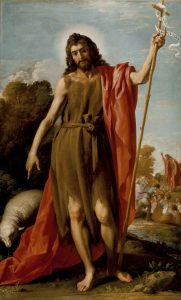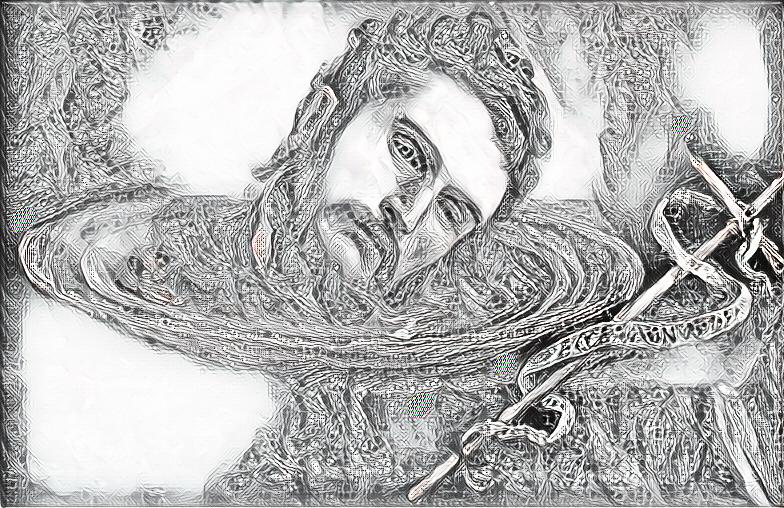The following is the first installment of a two-part series.
The wild hair, the scratchy clothing, the grit and body odor, and the exotic diet. All of these images typically come to mind when one mentions John the Baptist. He is a cartoonishly fiery, angry (and a wee bit insane) prophet railing against the system like an ancient hippy. He is the wild and crazy opening act to the more staid main event of Jesus. The canonical Gospels are quite consistent in their understanding of John’s character and role. He is not the messiah, but rather the one who urges that the way be prepared for the advent of the messiah.
John’s call from the wilderness is a two-step process. His cry for a baptism of repentance is a call to deconstruction. It is a plea to turn back from that which is not of the kingdom of God. According to the Gospel of Luke, John urges his listeners to “bear fruits worthy of repentance.”
He tells the gathered crowd to share their food and coats, tax collectors to collect only the amount prescribed to them, and soldiers not to extort money. He is clearing the ground of those obstacles which impede just relationships. He is pruning away those things that limit the possibility of the coming Basilea of God. It is dipping the static structures of oppression into the tehomic waters of the Jordan in order to shake loose new possibilities.
John’s baptism is, further, an opening into the eschatological possibilities of the Kingdom, an “othering” transfiguration, and an appearance of Irish Catholic phenomenologist Richard Kearney’s “God who may be.” It is an advent that opens the baptized up to the unique messianic possibilities which engulf them. Just as John’s unique persona attracted followers and created a community moved by the possibilities of the God of promise, a community that included Jesus, so too through this baptism we today can be moved towards openness to the potentialities of the divine.
Might this baptism, then, lead the way toward a Kearnian hermeneutic of opening possibility? A watery vision of the God who may be? To explore this question, I suggest that it is worth taking a Kearnian look at the portrayal of John in the Gospel of Luke.
Prosopon and Possibility
Preliminarily, though, I should point out that while Kearney does not write about John the Baptist,[1] I would argue that some inferences can be made about the way that he might describe John’s persona by examining Kearney’s description of Jesus as persona. Using what he terms “a phenomenological-hermeneutic retrieval rather than … theological exegesis per se,”[2] he highlights the Transfiguration texts in examining the figure of Christ. Specifically, he argues that at Mount Thabor “the person of Jesus is metamorphosed before the eyes of his disciples into the persona of Christ.”[3]
Kearney argues that his notion of persona (or the Greek version, prosopon, which Kearney uses virtually interchangeably with persona) is eschatological, not teleological. That is, there is no foreseeable or predictable goal or outcome to which the persona of the “other” who is encountered is aimed. Rather, the other is moving towards open and surprising potentialities which we have no power to control or define. The persona is always just beyond our grasp. The persona or prosopon, usually translated as “face,” is the “eschatological aura of ‘possibility’” exuded by a person.”[4]
It is the overflowing or exceeding of a person that makes them an Other, in Levinasian terminology. It is this exceeding, transcendent aspect of the person that is the space of the possible. The persona is the “capacity in each of us to receive and respond to the divine invitation.”[5] It is our human openness to the divine opening of the possible.
In a response to Kearney’s work, philosopher John Panteleimon Manoussakis points out that while prosopon is generally translated as “face” or “person,” such translations can skew one’s understanding of its ancient meaning. He notes that “the term is used exclusively with the verb ‘to be’ and never with the verb ‘to have.’ It makes sense only if one states that someone is a prosopon.”[6] Prosopon is not possessed, but is more like a stance taken.
Manoussakis goes on to elaborate that since pros means “toward” or “in front of,” prosopon is best understood as “to be-toward a face” or “in front of someone’s face.”[7] Prosopon or persona is, then, an event that necessarily involves relationality. Being a prosopon requires an encounter with an Other who is also (or becomes also) a prosopon.
The encounter of personas is a dynamic event ripe with ethical implications, rife with echoes of Levinas. In being part of the interplay of face-to-face gazes and mutual othering, an ethical personhood is developed. Manoussakis writes, “Prosopon strongly implies the reciprocity of gaze through which the self is interpellated by the Other and, ultimately, ‘othered.’ The passage toward the Other leaves my existence vulnerable to the fear and trembling of the infinite possibilities that await me.”
Thus, the infinity of the other compels an ethical relationship to the other, à la Levinas, but also with hints of William James’ eschatological ethics.[8] The infinity of the persona is an opening to the vulnerability of possibility. Manoussakis continues,
the dynamic (i.e., full of potential) character of the person makes “the possible” a personal (prosopic) category par excellence. Personhood … is never to be understood as a fait accompli or a once-and-for-all given that somehow we possess. Rather, to be a person suggests a process continuously occasioned by the unreserved exposure to the Other.[9]
![]() Kearney terms the encounter of a persona with another persona a “prosopon transfiguration.”[10] Such a transfiguration is a call of the other to the self that completes the self and opens it to heightened eschatological awareness of the ethical possibilities. The transfiguration of the persona is an opening to divine possibility. As Paul Symington, another commentator on Kearney’s work, notes, persona is always both already present and still to come.[11]
Kearney terms the encounter of a persona with another persona a “prosopon transfiguration.”[10] Such a transfiguration is a call of the other to the self that completes the self and opens it to heightened eschatological awareness of the ethical possibilities. The transfiguration of the persona is an opening to divine possibility. As Paul Symington, another commentator on Kearney’s work, notes, persona is always both already present and still to come.[11]
This messianism of the possibilities of the persona serves as a gateway to the “Kingdom of the Possible.” The Kingdom of the Possible is, for Kearney, the messianic potentiality for justice being actualized in the world. It is an invitation to humans to participate in the realization of that justice.
When and insofar as humans partake in the Kingdom of the Possible (that is, participate in ongoing prosopon transfiguration), the divine is manifested in the world. Kearney writes, “in every moment there is the possibility of good and the possibility of non-good. There’s the possibility of love; there’s the possibility of hate, violence, aggression.” God is when we choose love, and is not when we do not.
Kearney goes on to say, “every moment we are actualizing the Kingdom or not-actualizing the Kingdom.”[12] His sense of the divine, then, is that it unfolds in the possibilities of the ordinary activities of daily life, and through the hope in the possibilities of the future. There is no guarantee of the existence of God’s being, however, because of the human capacity to reject the messianic possibilities. The existence of God’s being in the world is a promise that may become actualized, depending on the human participation in that promise.
Thus, Kearney argues that the Kingdom of God – and in fact, God’s very being- is an eternal promise. In this sense it is imbued with a transcendent quality. The transcendent aspect of divinity, then, “is described [by a variety of biblical texts] as a possibilizing of divine love and logos in the order of human history where it would otherwise have been impossible. In other words, the divine reveals itself here as the possibility of the Kingdom.”[13]
As eternal, the Kingdom defies containment in chronology. It both is and is yet to come. He describes God as saying, “I will show up as promised, but I cannot be in time and history. I cannot become fully embodied in the flesh of the world, unless you show up and answer my call ‘Where are you?’ with the response ‘Here I am.’”[14]
God is the eternal promise made manifest in human response and the possibility of continued human response. French philosopher Stanislas Breton terms this move of Kearney’s a “micro-eschatology,” because it is forged in the minutia of daily choices rather than a grand cosmic scheme.[15] It is an eschatology of potentiality, not of teleology.
Such a focus on God as promise has a resonance with Martin Luther’s insistence on focusing on God’s promises (and the human response of faith in those promises), rather than a preoccupation with the existence of the divine. Church historian James Samuel Preus, for instance, holds that in Luther’s first Psalms course, he comes to see testimonia, or promise, as the normative meaning of the entire Bible.
Preus argues, “With Luther, something different has now appeared: promise, or testimony, as Scripture’s normative, theological-literal meaning, together with faith as the goal of interpretation.”[16] The wider theological implication of this biblical understanding of promise, according to Preus, is a break with medieval understandings of grace and faith. Preus writes, “Grace-as-intellectus is being thoroughly undermined … Therefore, faith is not the grace of intellectus, but the trust of future things that are promised.”[17]
Thus Preus’ argument demonstrates that, for Luther, God speaks to humanity through words of promise, which through grace inspire a faithful trust in the divine activity in the world.
Yet Luther goes even further in tying the promise of God’s action in the world to the faithful human response. In The Babylonian Captivity of the Church, for instance, Luther writes,
For God does not deal, nor has he ever dealt, with man otherwise than through a Word of promise. …We in turn cannot deal with God otherwise than through faith in the Word of his promise. He does not desire works, nor has he need of them; … But God has need of this: that we consider him faithful in his promises [Heb. 10:23], and patiently persist in this belief … [P]romise and faith must necessarily go together. For without the promise there is nothing to be believed; while without faith the promise is useless, since it is established and fulfilled through faith.[18]
Faith here is more than simply intellectual assent, but is rather a participation in the promises of God. Faith, for Luther, is the basis of hope and love; it is thus the basis for the possibility of participation in the divine promise. The category of promise and faithful response in a sense overcomes the dichotomy of signifier and referent, and permits an active participation in the gap between them.
There is a notable resonance here with Kearney’s sense of God’s enfleshment in the world through human response to the promise. Of course, Luther’s eschatology is much more teleological than Kearney’s is. Nevertheless, the two share a sense of the relationship between God’s promise and the active human response of faith that concretizes that promise.
 Jesus’ Transfiguration and Persona
Jesus’ Transfiguration and Persona
Because the Messiah is always still to come, while already having come as well, there can, for Kearney, be no once-and-for-all messianic moment. There are, however, moments where the divine possibilities are so intensely embodied that they can be looked back upon as paradigmatic moments of divine incarnation. He uses examples like Moses and the burning bush, but finds the clearest moment to be Jesus’ Transfiguration on Mount Thabor.
Kearney argues that, in the Transfiguration, Jesus is “othered” as Christ. The infinite transcendent overflow of his persona is manifested in the particularity of the person Jesus, in such a way that he was clearly still recognizable in his particularity and yet also clearly other than his everyday visage.
Kearney points to the importance of the face in the Transfiguration scene, writing,
Saint Luke’s Gospel tells us that as Jesus was praying, ‘the aspect of his face (prosopon) was changed and his clothing became sparkling white’ (Luke 9:29-30). Note that it is the face that registers the transfiguring event, marking an ethical openness to transcendence which refuses idolatry.[19]
In this opening of his face to the possibilities of the God of promise, Kearney calls Jesus as Christ the prosopon par excellence.[20] Jeffrey Bloechl, another philosopher of religion, explains that for Kearney, “It is in and through Jesus…that we may catch sight of the spiritual dimension of a humanity…irreducible to physical and material concerns – the dimension that opens each of us to his or her own future beyond the limits of this world.”[21]
Christ in this sense is a paradigmatically deep opening of the person to the persona and the potentialities lying therein. Again, Kearney argues, “Christ [is] the possibility of all humans becoming ‘sons of God’ – that is, by being transfigured into their own unique personas.” Christ is related to the historical figure of Jesus, but exceeds that particularity as a promise of potential, as “a way not a terminus, an eikon not a fundamentalist fact, a figure of the end but not the end itself.”[22]
Thus, for Kearney, Christ seems to be what empowers humans to be open to the uniqueness of their own persona, while Jesus’ unique persona is encompassed in Christ. Yet Kearney seems to reserve the title of Christ for Jesus’ openness to his own persona.
When he writes of “Christ,” he means specifically the persona of Jesus. His own system would, I contend, call for a wider conception of Christ. His assertion that Christ is the possibility of possibility – that is, of each person opening to their unique persona – would seem to argue for a notion of Christ as the enabling of the opening, something like the catalyst for the prosopon transfiguration.
Certainly, Kearney would not want to argue that Jesus is the sole example of incarnation or the only coming of the Messiah. His entire understanding of messianism is that it is always to come as much as it has already happened. Indeed, he shares in an interview his belief that the Messiahhasshownupinhistoryregularly, saying,
With Elijah in the cave the Messiah came. But that wasn’t the end of it. The Messiah came to John the Baptist, too, the voice crying in the wilderness. God always comes and goes. And that’s the nature of the Messiah: it’s already here – the Kingdom is already here – but it is also not yet fully here.[23]
His terminology of “Christ” as Jesus’ persona, then, is at best perplexing. I would suggest that Christ is better understood as the full meeting of the person with the possibilities of the Kingdom, a meeting that occurred for Jesus in a way that made him intimately linked with “the Christ,” but not in such a way as to grant him exclusive use of the title.
Eric Trozzo is Director of the Lutheran Study Centre at Sabah Theological Seminary in Kota Kinabalu, Malaysia. He holds a PhD in Theological and Philosophical Studies from Drew University. He is the author of Rupturing Eschatology: Divine Glory and the Silence of the Cross (Fortress, 2014), and is currently completing a manuscript entitled The Cyberdimension: A Political Theology of Cyberspace and Cybersecurity.
[1] He does make brief reference to the presence of the messiah to John the Baptist in an interview, which will be noted later.
[2] Richard Kearney, The God Who May Be, (Bloomington, IN: Indiana University Press, 2001), 39. Hereafter noted as GMB.
[3] Ibid.
[4] Ibid., 10.
[5] Ibid., 2.
[6] John Panteleimon Manoussakis, “Prosopon and Icon: Two Premodern Ways of Thinking” After God, John Panteleimon Manoussakis, ed. (New York: Fordham University Press, 2006), 283.
[7] Ibid., 284.
[8] For more on the connection between the ethics of Kearney and James, see Paul Symington, “Beyond Continents: Eschatological Dimensions in the Philosophy of William James and Richard Kearney,” Philosophy Today, 50:3, Fall 2006.
[9] Manoussakis, 284-285.
[10] GMB, 18.
[11] Symington, 268.
[12] Richard Kearney Interview with Mark Manolopoulos, in After God, 373.
[13] Richard Kearney, “Enabling God,” After God, 41.
[14] Ibid., 43, author’s italics
[15] Stanislas Breton, “On the God of the Possible” After God, 180.
[16] James Samuel Preus, From Shadow to Promise: Old Testament Interpretation from Augustine to the Young Luther, (Cambridge, MA: Belknap Press, 1969), 189.
[17] Ibid, 256.
[18] Martin Luther, The Babylonian Captivity of the Church, in Martin Luther’s Basic Theological Writings, Ed. Timothy F. Lull, (Minneapolis: Fortress Press, 1989), 298.
[19] GMB, 40.
[20] Ibid.
[21] Jeffrey Bloechl, “Christianity and Possibility,” After God, 135.
[22] GMB, 43, author’s italics.
[23] Interview, 373.




